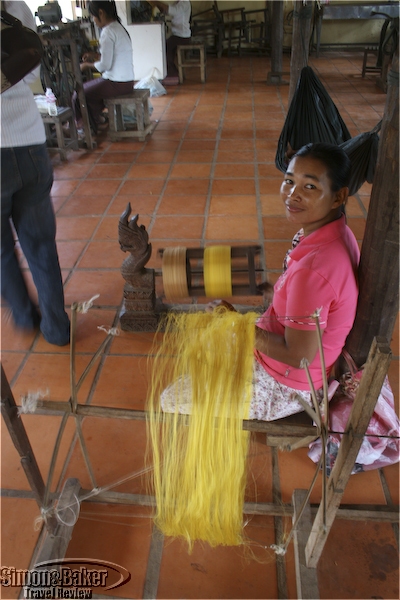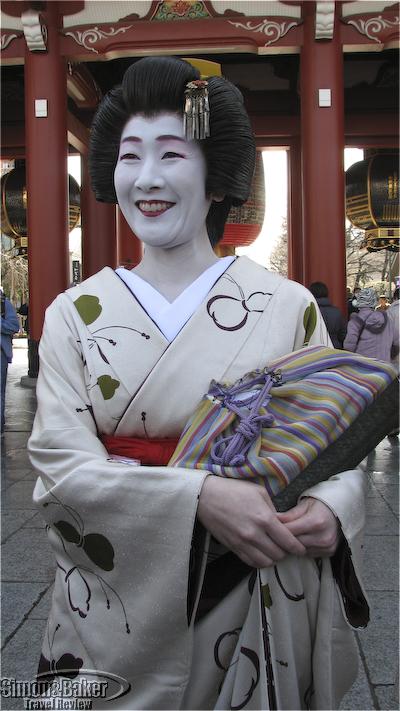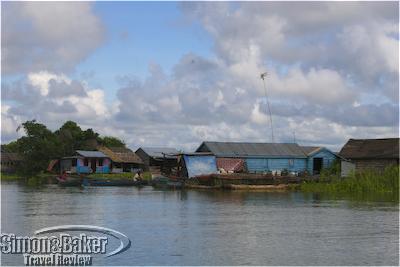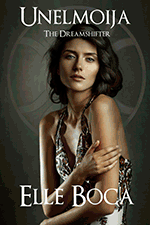by Editor | Nov 7, 2011 | Attractions, Ecotourism
Article and photos by Elena del Valle

High fashion dresses were on display in the shop
One of the off the beaten path activities I most enjoyed during a trip to Siem Reap, Cambodia this year was a tour of the Golden Silk Pheach farm, about an hour away from the city. As soon as I found out about the farm I was intrigued. With the help of the staff at my hotel I scheduled a guided visit. This required advance planning as visits, with the owner, were strictly by appointment.

Oum Sophea Pheach explains the process of creating silk fibers
What impressed me about the Golden Silk Peach, before even visiting the farm and store, was the sheer dedication and determination of its owners. Oum Sophea Pheach, a Cambodian and former director of the National Center of Cambodian Silk, and her husband Patrick Gourlay, a French banker, had the vision to manufacture rare fine golden silk in their own farm. In 2002, they created the project from the ground up, funded the farm 32 kilometers from Siem Reap and trained 100 staff (many of them young and disadvantaged rural residents).

The deep golden color produced by the silk worms
It would be nine years before the first silk production was successful. Visiting the farm and watching the staff at work was a learning experience. The painstaking process required time, skill and patience. A single unique silk fabric could take months to manufacture.

The next stage is to make thread from the silk
Visiting the shop was an exercise in restraint. In addition to fine silk textiles and silk products made at the farm, the shop sold art (sculptures, stone, wood, bronze and cotton items) produced in the area. The Golden Silk ikat designs and colors varied; prices ranged from $50 for a basic scarf to $1,200 for an elegant silver gray wrap I fell in love with and as much as $15,000 for an elaborate large wrap.

The cloth is woven by hand
For tourists who couldn’t spare the time to drive to the farm and wished to see the silk products the owner offered private display and sales at her home (by appointment only), a handsome and lovingly built property in one of the most exclusive neighborhoods of the city. We stopped there after the tour of the silk farm. Golden Silk Pheach (+855 (0) 12 59 68 11, sophea@goldensilk.org, http://www.goldensilk.org)
by Editor | Jul 18, 2011 | Attractions
Article and photos by Joachim Castellano

Early Panasonic radios and tape players
The Konosuke Matsushita Museum, established 1968, is a small one-story exhibition space located on the campus of the global giant electronics company, Panasonic. The museum, located about 20 kilometers from Osaka, tells the story of the stratospheric rise of Panasonic’s founder Konsuke Matsushita to one of the world’s most successful industrialists. Inside a cozy building modeled after the original 1933 Panasonic head office many first generation consumer electronics are on display, from TVs to washing machines.
It was fascinating to see the initial models, whose design genius us modern folk have come to ignore like windows and doorknobs. Panasonic’s first radio, made of beautiful wood with a distinctive octagonal speaker, was likely met with the same jaw-dropping awe awarded to today’s smartphones and tablet computers. To the digital generation, these gadgets might appear as ancient as Egyptian artifacts. However, digital DJ’s should pay respects and bow at the altar of the Technics Turntable record player, a key tool that set stage for art forms such as hip hop and dance music.

Early models of televisions and washing machines on display
The museum is not just a historical hit parade for Panasonic merchandise. I glimpsed into a time capsule of Japanese history after the devastation of World War II. On display are copies of Time and Life Magazine from the 1960s whose cover stories feature Japan. It was interesting to witness the American media coverage of Japan’s transformation as it was happening. The issue of Time on display features an interview with Matsushita, whose success story parallels Japan’s rise as an economic superpower.
Aspiring CEOs might also find golden nuggets of advice from Matsushita’s teachings on business. His process, I had the impression, created global hit products for decades. The basic business principles he developed are still practiced by Panasonic today. The future Bill Gates or Steve Jobs should not miss visiting this gem of a museum.

Early magazine articles from Time and Life were on display
Signage and information was available in Japanese and English. A few video and audio clips were in Japanese only. The museum, owned and managed by Panasonic Corporation, was a three minute walk from Nishi-sanso station on the Keihan Line.
The Konosuke Matsushita Museum might be small in size, but it is rich in Japanese and electronics history. It houses models of the world’s first VHS VCR along with information about post-war Japanese history and corporate management. Konosuke Matsushita Museum, 1006, Kadoma, Kadoma City, Osaka 571-8501, Japan, + 81 06-69 060 0106, fax: + 81 06 69 06 1894, http://panasonic.net/history/museum
by Editor | May 31, 2011 | Accomodations, Attractions, Luxury Travel, Restaurants, Video
Article and photos by Elena del Valle

A temple in Tokyo
Earlier this year, before the earthquake hit, I spent a few days in Japan. Although my calendar was overfull it had been years since my last visit to Japan and I couldn’t resist a last minute invitation to the Land of the Rising Sun. Finding a desirable seat on the flights nearly caused the trip to fall apart before it even started. In the end I persevered and with the help of a friendly airline agent everything worked out.

A beautiful garden and bridge in Tokyo
On my arrival at Narita International Airport, I cleared the airport formalities with ease and was thrilled the transfer service driver was waiting for me. He spoke English very well, allowing us to chat during the drive to the Hotel Okura Tokyo (2-10-4 Toranomon, Minato-ku, Tokyo 105-0001, + 81 03 3582-0111, http://www.hotelokura.co.jp/tokyo/en/), where I spent the first three nights in the city. The eleven story contemporary hotel located across the street from the United States Embassy, had 801 rooms, modern facilities, nine restaurants, a fitness center with a swimming pool ($70 per day for hotel guests), spa, ATMs friendly to foreign credit cards, WiFi router for rent (a router compatible with my iPad cost 4,725 yen or about $18 a day at the time) and service oriented English speaking staff. My room was contemporary in style and new looking with a glass enclosed shower, a separate bathtub and a Japanese toilet.

An old versus new contrast with a temple column in the foreground and the Sky Tree in the background
The first day I had breakfast at the Terrace Restaurant, a ground level restaurant facing a snow covered inner courtyard at the hotel. I liked the buffet’s Eastern and Western selection and a delicious tea made from fresh herbs. Later during my stay I sampled some of the items sold at the restaurant’s shop and was quite pleased with the quality.

Breakfast at Yamazato restaurant at the Hotel Okura
By far my favorite breakfast in Tokyo was at Yamazato, the hotel’s Japanese restaurant. As I descended the stairs to the restaurant a young man at the entrance welcomed me in English and led me to a table. Even though the two times I was there I was the only Westerner I felt welcome. The wait staff spoke a few words of English making it possible for us to communicate basics. The servers brought me a glass of water when they spotted my vitamin pack. One of them offered to serve me beef or pork in case I didn’t want fish but what is a Japanese breakfast without fish?

A waitress at Yamazato restaurant at the Hotel Okura
The Japanese breakfast came in a bento box with rice, fish dish (sauteed yellowtail, octopus), hearty and especially flavorful miso soup, pickled vegetables, steamed vegetables, bamboo shoots, mushroom, eggs, and a couple of unidentified dishes. Everything was delicious.

The Tokyo skyline from the Mori Building
In the same way that New York is associated with the Big Apple, Sumiyo, our tour guide, explained, visiting the city of Tokyo can be thought of as exploring an egg. Architecture Guide in Tokyo, a color brochure in English, explained the ways in which Tokyo is like an egg; a handy map on the back pointed to the salient architectural areas of the city. The 284-acre imperial palace appeared in the lower right side of the egg. The inside of the brochure contained a series of descriptions of architectural areas of note within the city based on the egg simile: Omelet-rice for semi-European before 1945, Bacon egg for Western styles before 1945, Atsuyaki tamago Japanese style before 1945, Egg sand for modern style between 1945 and 1975, Boiled egg for plain style between 1976 and 1985, Scrambled egg for post modern style between 1986 and 1995, and Pudding after 1996.

The National Art Center in Tokyo
During the next two days, we would be seeing several neighborhoods within the “egg” of Tokyo, a metropolis of 13 million souls established in 1868 following the collapse of the shogun government. We began across town from our hotel with a visit to Edo Kiriko in Hanashyo (http://www.hanashyo.com), a 60 year old family owned fine cut glass store and workshop. The traditional Japanese home where it was located had such narrow spaces only four or five people could enter at one time. During our visit we watched the owner and his young apprentices engrave and hand polish each colorful piece without using hydrochloric acid at a ground floor workroom, and we saw the finished cut glass pieces on display in a small upper floor showroom. Hanashyo sold Kome-tsunagi, Itokiku-tsunagi and Tama-ichimatsu, three registered proprietary designs. We also visited a second showroom where glass cutting classed were offered. We were invited to experience cutting glass for ourselves for a couple of minutes each. It was fun.
One of my favorite experiences in Japan was a special abbreviated daytime performance of four geishas at Hisago-an restaurant (in Japanese only, http://kaiseki-hisagoan.com/course_hisagoan.html/). The geishas we saw that day normally only perform at the restaurant at night. Three of them danced, one sang briefly and the most senior one played a banjo like instrument. Following the dance they demonstrated one of the games they play while entertaining guests and, with the help of an interpreter, answered questions. In their company we took a rickshaw ride from the restaurant to Senso-ji (http://www.senso-ji.jp/about/index_e.html ), a nearby Buddhist temple, and strolled around the Asakusa area and its well known outdoor shopping arcade next to the temple. It seemed everyone was staring at us until someone explained it was the geishas rare daytime stroll that drew public attention.

One of the geishas who walked with us
From there we drove to Omotesando Ukai-tei (http://www.ukai.co.jp/english/omotesando/index.html), a French influenced restaurant in a shopping mall where we had a Tenderloin Lunch Course, a refined and delicious four-course lunch. During the meal we noticed fine Ercuis French silverware and wood chopsticks, Reidel glassware, and embroidered napkins. We were served Dermotte non vintage Champagne followed by Assorted Appetizers, Roasted Bamboo Shoots, Shellfish Cream Soup, Ukai Beef Tenderloin Pan Fried and Dessert. Although we didn’t have a view from our seats the bar area had pretty city views. The restaurant, part of a chain of restaurants and museums, housed an exhibition space with a perfume bottle collection and a dessert lounge with Art Nouveau ceilings and lacquered pillars.

The main location of Mitsukoshi Nihonbahi, one of Tokyo’s most exclusive department stores
Following lunch we walked around the Omotesando and Aoyama areas. We visited the Espace Louis Vuitton Tokyo (Louis Vuitton Omotesando Building 7F 5-7-5 Jingumae, Shibuya-ku, Tokyo 150-0001, +81 03 5766 1088, www.espacelouisvuittontokyo.com) which was hosting French artist Xavier Veilhan; and the Ukiyo-e Ota Memorial Museum of Art (http://ukiyoe-ota-muse.jp/index-E.html), housing a collection of Ukiyo-e Japanese woodblock art.

Strawberries for sale in the food hall of the Mitsukoshi Nihonbahi store
The next day after my delightful Japanese breakfast I was ready to face the cold again. This time we visited the main location of Mitsukoshi Nihonbahi store (Nihombashi Muro-machi 1-4-1, Chuo-ku, Tokyo 103-8001, +81 03 3241 3311, http://www.mitsukoshi.co.jp/store/fcs/english/1010/index.html), one of the most exclusive department stores in Tokyo. We arrived just in time to watch the opening ceremony at 10 a.m. during which the store staff welcomed arriving guests with deep bows. My favorite area of the beautiful and well stock multi-story store was the lower level where the food shops were located. It was filled with all types of hard to find eatable items including pastries, seafood, meat, chocolate, vegetable and fruit delicacies. I could have spent at least another hour exploring the food halls and tasting samples.

Another view of the city from the Mori Tower
From there we went to the Mori Tower in Roppongi Hills for an outstanding skyscraper view of Tokyo (http://www.roppongihills.com/tcv/en/ ). That morning we visited Tokyo Midtown, walked by the Mori Art Museum (http://mori.art.museum/eng/index.html) dedicated to promoting “art and life in the 21st century,” and the Suntory Museum of Art (http://www.suntory.com/culture-sports/sma/) dedicated to challenging conventional attitudes to the classification of art to reveal its beauty.

A display at the food hall of the Mitsukoshi Nihonbahi store
Lunch was at Rakutei (+81 3585 3743), a tiny family owned restaurant in Akasaka. Although there was no sign on the building to indicate the existence of a restaurant once inside we were welcomed in Japanese and invited to enter. We sat at a small counter facing an open cooking area. At first it looked like a sushi bar but we soon discovered it was not. An elderly man and his assistant were busy preparing the meal while the man’s wife placed dinnerware in front of us and offered us beverages. We had warm sake and a delicious tempura lunch served two bites at a time until we surrendered.

The interior of the National Art Center in Tokyo
After a lightning fast visit to the National Art Center (http://www.nact.jp/english/index.html ), a 14,000 square meter large venue for temporary art exhibitions, we ended the day with a stroll in a Ginza district shopping street. Ginza, meaning place where money is made in Japanese, is one of the most popular and most expensive tourist shopping areas of Tokyo, our tour guide explained.

A dragon water fountain in Shuzenji Village
After breakfast the next morning we drove to Shuzenji, a two and a half hour drive from Tokyo, for an overnight stay at Yagyu-no-sho, a traditional Japanese ryokan. By the time we had a tour of the traditional style ryokan, found our rooms and explored the area by the ryokan it was time for dinner and we retreated indoors.

A stone head at the entrance to the Shuzenji Temple
The next day our visit to a local pottery artist’s shop was canceled providing an unexpected opportunity to stroll through Shuzenji Village, exploring the shops and visiting the interior of the Shuzenji Temple, a rare treat before our return home.
by Editor | Jan 24, 2011 | Attractions
Article and photos by Elena del Valle

Getting to Siem Reap, Cambodia, the nearest city to the world famous Angkor Temples, from the United States required many hours of travel and a change of airplane in several cities. After spending a few days in Thailand to adjust to the eleven hour time difference and relax a little I headed to Cambodia with some trepidation (after reading about incidents with visas and border guards among other issues). To minimize problems I paid the extra fees to purchase a Cambodian visa online ahead of my trip and requested an airport transfer from the Hotel de la Paix, my Siem Reap hotel. Fortunately my stay was without incident.

As we were landing I saw miles of emerald green fields and began to feel excited about visiting the area. My flight from Bangkok, Thailand arrived early in Siem Reap so that when I exited the customs area I almost missed my driver. He was English speaking and friendly, making the drive from the airport to central Siem Reap pass by quickly.

When I arrived at the hotel I breathed a sign of relief. Friendly and welcoming faces greeted me as soon as we stopped at the hotel’s porte chochere. I immediately liked the new looking and pretty hotel where I would be staying during my five nights in Cambodia. I knew I would be comfortable and safe. With the help of the hotel staff we planned my outings, filling the early part of my days with visits to the Angkor Temples.

By 6 a.m. most mornings I would be on my way to the nearby temples in the company of Chhai Heaor, a hotel driver, and Pouv Siya, an English speaking official guide and photography lover. Both of the young men were courteous and professional in their demeanor, and service oriented. My guide, a self starter who was learning Spanish online in order to increase his income, was keen to show me the many photography oriented angles for the temples and statues he had discovered.

Pouv Siya, my guide
The reason for the early departure was to avoid the ubiquitous crowds at the temples and catch the temples at the best early morning light for photography. I chose to see fewer temples and spend quality time at each one, stressing my preference for crowd free visits whenever possible. My friendly guide was quite pleased with the news and able to accommodate my request.

Between the early arrival time and my guide’s familiarity with the temples (as well as the seasonal rains which invariably caught us) we were fortunate to enjoy relative quiet at the temple sites. Although there were always many other visitors at each temple, often they were in another area of the temple or arriving when we were leaving and for the most part we avoided lines, loud visitors and overcrowded areas.

During three outings of several hours each on three different days we visited Angkor Wat, the most famous (and most crowded), Ta Prohm, Bayon, Sras Srang (King’s Pool), Banteay Srey (Lady Temple), Pre Rup (Red Temple). The temples were in a state of disrepair from years of neglect; many of the statues were beheaded, and there was always standing water sometimes inside and outside. Walking required attention as the ground was uneven and at times very slippery, especially just after it rained and it rained daily, sometimes more than once in a day. At several of the temples there were major restoration projects taking place. Although this was a good thing in the long term during our visit it meant that the tall metallic cranes, scaffolding and staff members at work marred the view of the temples.

The temples were striking, elegant and memorable. Each temple had its own charm although some were far more popular than others. My favorites were the tree filled Ta Prohm famed for the scenes in one of the Lara Croft movies, and the smaller, less imposing and more intimate Banteay Srey. The Lady Temple was popular in spite of the drive through the countryside that was necessary to reach it. Fortunately, the drive was on a good road where we had a chance to glimpse local homes and monks on their daily rounds. Once at the temple there were clean and modern restrooms and a covered entrance where we took refuge from the rain briefly.

In addition to our early morning arrivals, a little rain gear and some advance planning made it possible for us to miss most crowds and lines. As we walked along the temples, admiring their beautiful artwork I was glad I had made the trip to Cambodia. I look forward to a return trip with my husband to discover more of the temples, the people and the natural treasures of Cambodia.
by Editor | Jan 10, 2011 | Attractions
By Elena del Valle

The Canopy Adventures office
On a recent visit to the island of Koh Samui in Thailand I went on a canopy ride. The mid morning ride provided an off the beaten track activity and a pretty bird’s eye view of the local greenery including a waterfall. At my request after seeing the activity listed among the hotel tour offerings, the hotel staff at the Hansar Samui, my beachfront hotel on the northern coast of the island, coordinated the outing. The hotel sorted out reservations and provided transportation to the canopy ride site.

Canopy Adventures
From the paved road a few minute’s drive from the hotel we followed a bumpy dirt road that made me glad we were in a four by four vehicle. When the road ended we found a steep uphill path. At the top of the path there was a small thatched roof hut where three staff welcomed us. Since only two of us were scheduled at that hour we were able to begin quickly. We signed in, promised not to sue them in case of an accident and proceeded with the tour. Minutes later we donned canopy gear and thick gloves (mine smelled awful) and continued up a hilly path to a training spot in the company of two of the friendly staff members.

Ladders to the canopy
A sea of mosquitoes greeted us while we listened to their explanations in thickly accented English. Additional climbing led us to the first of several treetop platforms. Although it was harder than it looked when the guides showed us and required upper body strength to slow down and stop while moving down the line, it looked very safe. Soon we were zipping along the trees and screaming delightedly. The heat and humidity were high even though the sky was mostly overcast. Sweat dripped from our faces and my sunglasses fogged up so much they became useless so I let them hang around my neck.

The secret falls
When we arrived at the last zip line we felt small rain drops. We rushed back to the starting point just in time to miss the pouring rain. While the next group of tourists waited for the rain to stop we wolfed down a plateful of sweet watermelon they offered us and pondered how the ride had gone by so quickly. A short while later the rain slowed down. We took advantage of the lull to say good bye and made our way back down the steep path to the car.
After cleaning our hands with refresher towels in the vehicle we headed back to the hotel in air conditioned comfort, drinking bottled water to quench our thirst while planning our next adventure. Canopy Adventure (Thailand) Co Ltd, PO Box 28, Meanam, Koh Samui, Suratthani, Thailand 84330, Phone + 66 077 414 151, www.canopyadventuresthailand.com, info@canopyadventurethailand.com
by Editor | Dec 6, 2010 | Attractions, Ecotourism, New Articles
Article and photos by Elena del Valle

A young boy in a tiny boat floats through the village
During a recent trip to Siem Reap, Cambodia I had an opportunity to spend time in a conservation area and bird reserve near the city. Although the conservation area we visited was only 90 minutes by car and boat from the central urban area where my hotel was it was vastly different from the hustle and bustle of the city. Spending time in an area visited by only 150 bird and conservation enthusiasts a year was special. As the word spreads about the eight conservation areas that it is possible to visit in Cambodia and tourism to the region continues to grow the number of visitors to the reserve will likely grow as well. For now, it is still a pleasure of serene lake and birding panoramas.

Most of the village floated on the water
Nick Butler, the coordinator of the Sam Veasna Center for Wildlife Conservation, and Sophoan Sanh, a senior tour guide with five years of experience with the Center, escorted me on a day long Bird Reserve and Floating Village Day Trip on Tonle Sap Lake. To take advantage of the weather and avoid rain as much as possible we set out at 6 a.m. on a weekday morning. We drove from my hotel in central Siem Reap through the countryside to the shores of Tonle Sap Lake, the home of, and an important source of livelihood for, many Cambodians; where we boarded a 10 meter wood motorboat with a 110 horsepower engine, curtains (in case of rain) and an upper deck (we were quite thankful for the curtains and cover when it rained) to traverse the lake in a west southwest direction to our destination, the Prek Toal Bird Sancuary and the nearby village of Prek Toal.

Map of Cambodia
Along the way Nick, a native of the United Kingdom, and Sophoan, a Cambodian, shared information about the lake and its importance for the local communities, the birds in the area and the environment while we munched on the goodies from the breakfast boxes they had brought along. Although there was plenty of space in the shady comfort of the boat we climbed onto the upper deck to better view the lake and the birds. On our way through the conservation area to one of the main floating villages we stopped at an observation point, a tree where Center staff spent time to monitor and protect the bird nesting areas (sometimes the fishermen were drawn to them because of the excellent fishing they offered). From the canopy of the tree we could see for miles around the lake, including approaching rain clouds. It was a beautiful sight. Although there was a seemingly infinite variety of insects that rained on us when we brushed the trees as we motored around the reserve I saw not a single mosquito and for that I was thankful.

Boats of many descriptions were the core of local transport
At the Prek Toal floating village we picked up a representative of the Cambodian parks and made a restroom stop (although there was a toilet on the boat it was tiny and without toilet paper) before heading to a local house for lunch. The village was a lively place with residents going about their everyday lives in their floating homes and businesses or making their way from one location to another by boat. Lunch, prepared by a village family who had received special training, was delicious.

A non floating temple in the floating village
After lunch, a teenage member of the family showed us around the village in a small rowboat. I particularly enjoyed the water level view we had on the boat that allowed us to see the inhabitants, their homes and businesses close up. Some came to their door to look at us with curiosity; at times children waived shyly and adults smiled when we waved back. After that we crossed the lake to reach our car for the short drive back to Siem Reap, arriving at my hotel in the late afternoon. The day trip remains one of my favorite memories of Cambodia.
Visit Simonandbaker.com for additional information about Siem Reap and my tour with the Sam Veasna Center for Wildlife Conservation.
















































